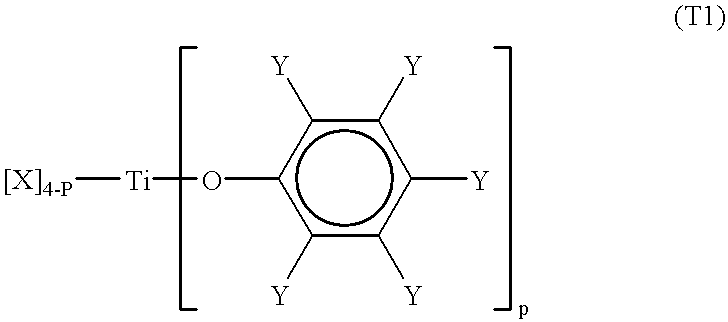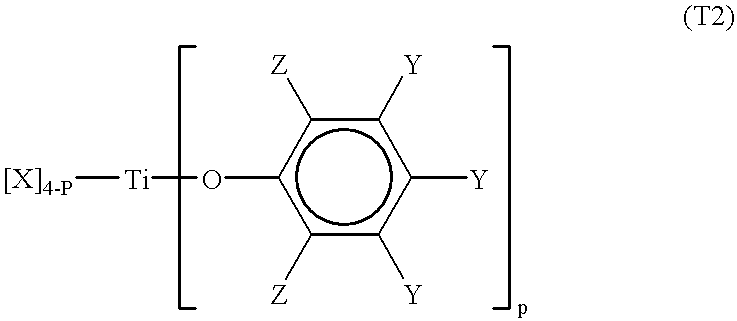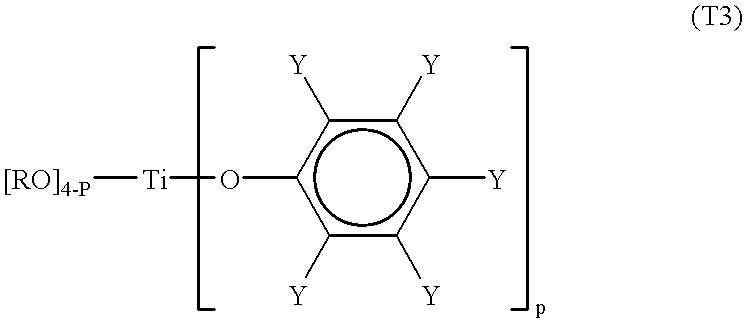Processes for the preparation of a monodisperse polymers, processes for the continuous polymerization of cyclic monomers, and polymers prepared thereby
a polymer and polymer technology, applied in the field of monodisperse polymer preparation, can solve the problems of deteriorating the heat stability of the polymer, difficult to obtain a polymer or a block-copolymer having a narrow molecular weight distribution, and difficult to control reaction heat, so as to improve the rigidity, improve the thermal stability, and facilitate the production of polyurethanes.
- Summary
- Abstract
- Description
- Claims
- Application Information
AI Technical Summary
Benefits of technology
Problems solved by technology
Method used
Image
Examples
preparation example 1
First Preparation of a Titanium-Type Lewis Acid
8.82 g, (40 mmol) of 2, 6-di-tert-butyl-4-methylphenol recrystallised using hexane were dissolved in 500 ml of dried hexane. 5.9 ml, (20mmol) of titanium (IV) isopropoxide were dropped in at room temperature. After the completion of dropping, the mixture was stirred for 2 hours and then heat at 60.degree. C. After heating, 450 ml of hexane was distilled out under reduced pressure. The mixture was then left at 0.degree. C. for 10 hours. Crystals of 2, 6-ditert-butyl4-methylphenyl-bis-substituted titanium-type Lewis acid (abbreviated as DiPti(BMP)) (A) were obtained. The re-crystallised crystals were washed twice with dry hexane and residue was vacuum dried (8.0g, yield of 67%). The crystals were then dissolved in dichloromethane to form a 0.3 mmol / l solution.
preparation example 2
Second Preparation of a Titanium-Type Lewis Acid
6.81 g, (20 mmol) of 2, 2'-methylenebis-(6-tert-butyl4-methylphenol), recrystallised using hexane, were dissolved in 500 ml of dried hexane. 2.2 ml, (20 mmol) of titanium tetrachloride was dropped at room temperature. After dropping, the mixture was stirred for 2 hours and then heat at 60.degree. C. to verify that the insoluble materials were dissolved. The mixture was then left at room temperature for 10 hours. Dark-red crystals of 2, 2'-methylenebis-(6-tert-butyl-4-methyphenol) two substituted titanium-type Lewis acid were obtained. The recrystallised crystals were washed with dry hexane and residue was vacuum dried (6.82 g, yield of 74.5%). The crystals were then dissolved in dichloromethane to form a 0.3mmol / l solution which was reacted at room temperature with a suitable amount of propylene oxide. The resulting titanium-type Lewis acid (B) having the structure as shown in Formula T3' was obtained. ##STR10##
preparation example 3
Third Preparation of a Titanium-Type Lewis Acid
6.19g, (20 mmol) of 2, 2'-methylenebis-(6-tert-butyl-4-methylphenol) recrystallised using hexane were dissolved in 500 ml of dry hexane. 5.9 ml, (20 mmol) of titanium (IV) isopropoxide were then dropped in at room temperature. After dropping, the mixture was stirred for 2 hours and then heat at 60.degree. C. After heating, 450 ml of hexane were distilled out under reduced pressure. The mixture was then left at 0.degree. C. for 10 hours. Crystals of 2, 2'-methylenebis-(6-tert-butyl4-methylphenol)-bis-substituted titanium-type Lewis acid (C) was obtained. The recrystallised crystals were washed with dry hexane and residue was vacuum dried (6.8 g, yield of 67%). The crystals were then dissolved in dichloromethane to form a 0.3mmol / l solution.
PUM
| Property | Measurement | Unit |
|---|---|---|
| Length | aaaaa | aaaaa |
| Substance count | aaaaa | aaaaa |
| Volume | aaaaa | aaaaa |
Abstract
Description
Claims
Application Information
 Login to View More
Login to View More - R&D
- Intellectual Property
- Life Sciences
- Materials
- Tech Scout
- Unparalleled Data Quality
- Higher Quality Content
- 60% Fewer Hallucinations
Browse by: Latest US Patents, China's latest patents, Technical Efficacy Thesaurus, Application Domain, Technology Topic, Popular Technical Reports.
© 2025 PatSnap. All rights reserved.Legal|Privacy policy|Modern Slavery Act Transparency Statement|Sitemap|About US| Contact US: help@patsnap.com



